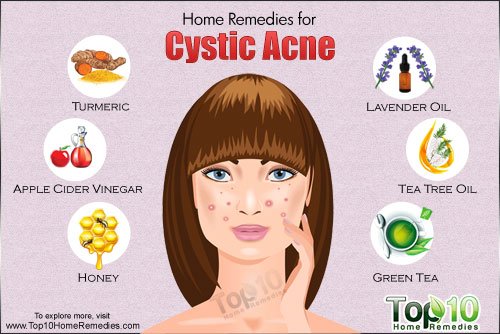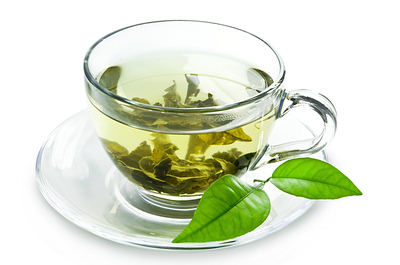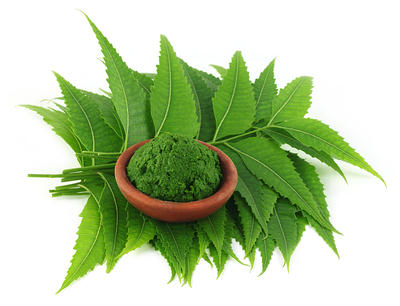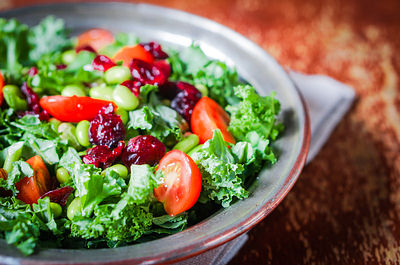Cystic acne is one of the most severe forms of acne. This type of
acne feels like soft, fluid-filled lumps under the skin’s surface.
These large, red breakouts can be painful and can cause significant skin damage, making the likelihood of developing scars extremely high. They tend to develop on your face, chest, back, upper arms or shoulders.
The skin pores are composed of hair follicles and sebaceous glands, the glands that secrete sebum. When they produce too much sebum, it clogs the pores along with the epidermal cells shed by the skin. When clogged pores become infected and the infection goes deep into your skin, it leads to cystic acne.
The biggest factor that contributes to cystic acne is hormonal changes that stimulate sebum production. Other factors include use of greasy cosmetics, excessive humidity or sweating, and certain drugs as well as chemicals.
Teenagers are more prone to develop this problem, given the hormonal changes going on in their bodies. However, anyone can have it.
Maintaining a healthy skin care routine as well as a healthy lifestyle is paramount to treat cystic acne. There are also simple home remedies that can effectively treat it by reducing inflammation and fighting infection.

Here are the top 10 home remedies for cystic acne.
Note: Some people tend to be allergic to tea tree oil. So, perform a skin patch test before using it.
It can pull out the excess oil from clogged pores as well as exfoliate dead skin cells. It even balances the pH level of your skin to leave it healthy and glowing.

Green tea contains natural antioxidants that help you enjoy healthy and glowing skin from the inside out. In addition, its anti-inflammatory property soothes irritated and swollen skin.
According to a 2012 study published in the Journal of Investigative Dermatology, a major component in green tea called epigallocatechin-3-gallate improves acne by modulating intracellular molecular targets and inhibiting p. acnes bacteria.

Indian lilac, also known as neem or margosa, is a popular Ayurvedic remedy for cystic acne. It contains antiseptic and antimicrobial properties that help fight the cause of the problem and reduce symptoms like pain and inflammation. Taking neem internally even helps detoxify your body and purify your blood.

Raw honey has antibacterial properties that can help cure cystic acne. Its antioxidant property helps prevent damage caused by free radicals. In addition, it makes your skin smooth and soft.

By making some dietary changes, you can reduce or prevent any form of acne, including cystic acne.
Early treatment can help prevent mild acne from progressing to widespread blackheads, whiteheads, and deeper cystic acne.
When combined with lauric acid a 2013 article suggested that curcumin has antibacterial activity against a number of bacteria including P. acnes which plays a role in acne causation.[3] Other research has suggested that curcumin can help in the management of inflammatory conditions, both topically and orally.[4]
Although there is much indication that turmeric’s anti-inflammatory properties can help acne, there haven’t been any large clinical trials showing a definitive benefit in treating or curing acne.
In the long run this can increase oil production and cause even more pimples. Toothpaste is meant for teeth not skin.
Source Click here
These large, red breakouts can be painful and can cause significant skin damage, making the likelihood of developing scars extremely high. They tend to develop on your face, chest, back, upper arms or shoulders.
The skin pores are composed of hair follicles and sebaceous glands, the glands that secrete sebum. When they produce too much sebum, it clogs the pores along with the epidermal cells shed by the skin. When clogged pores become infected and the infection goes deep into your skin, it leads to cystic acne.
The biggest factor that contributes to cystic acne is hormonal changes that stimulate sebum production. Other factors include use of greasy cosmetics, excessive humidity or sweating, and certain drugs as well as chemicals.
Teenagers are more prone to develop this problem, given the hormonal changes going on in their bodies. However, anyone can have it.
Maintaining a healthy skin care routine as well as a healthy lifestyle is paramount to treat cystic acne. There are also simple home remedies that can effectively treat it by reducing inflammation and fighting infection.

Here are the top 10 home remedies for cystic acne.
1. Turmeric
To get rid of this annoying problem, you can use turmeric. The spice contains curcumin, an anti-inflammatory compound that naturally relieves inflammation as well as pain. Plus, it acts as a natural antiseptic to fight infection.- Add a little water or unrefined sesame oil to 1 to 2 teaspoons of turmeric powder to make a paste. Apply this paste on the affected area and leave it on for about 1 hour before rinsing it off. Use this remedy once or twice daily for a few days.
- To treat the problem from within, add ½ teaspoon of turmeric powder to a glass of warm milk and drink it twice daily.
2. Apple Cider Vinegar
Apple cider vinegar is another widely used home remedy for cystic acne. Being an astringent, it helps remove excess oil to cure acne and reduce pain and inflammation. It helps cleanse the skin and balance the skin’s pH level. It- Mix equal amounts of raw, unfiltered apple cider vinegar and water. Dip a cotton ball in this solution and apply it on the affected skin. Let it sit for about 15 minutes, then rinse it off with water. Repeat the process twice daily for a few days.
- Also, add 1 teaspoon of raw, unfiltered apple cider vinegar and a little raw honey to a glass of warm water and drink it once or twice daily. This tonic will help prevent acne and other skin problems.
3. Tea Tree Oil
Tea tree oil is another common remedy for skin problems like cystic acne. It penetrates easily into the skin to help unblock the sebaceous glands, disinfect pores and dry out the acne.- Put 1 or 2 drops of tea tree oil onto a cotton ball and dab it gently on the affected area. Leave it on for a few hours or overnight. Those who have sensitive skin must dilute 1 part tea tree oil with 3 parts water.
- Alternatively, mix 4 or 5 drops of tea tree oil in 1 teaspoon of raw, organic honey. Apply this directly on the affected area, allow it to sit for about 15 minutes and then rinse it off with water.
Note: Some people tend to be allergic to tea tree oil. So, perform a skin patch test before using it.
4. Baking Soda
Baking soda is another popular ingredient for treating cystic acne due to its antiseptic and anti-inflammatory properties.It can pull out the excess oil from clogged pores as well as exfoliate dead skin cells. It even balances the pH level of your skin to leave it healthy and glowing.
- Mix 1 teaspoon of baking soda with enough cucumber juice to make a thin paste. If you do not have cucumber juice, just use plain water.
- Apply it on the affected area.
- Allow it to sit for a couple of minutes and then rinse it off with lukewarm water.
- Do this once or twice a week.
5. Fuller’s Earth
Fuller’s earth, which is a type of clay, is another effective remedy. It helps get rid of excess oil and dead skin cells to give way to clean and smooth skin. It even reduces the chance of scars forming.- Mix 1 to 2 tablespoons of fuller’s earth with enough water to make a paste.
- Mix in ½ teaspoon of honey.
- Apply it on your face.
- Allow it to dry on its own, then wash it off with water.
- Follow this remedy once or twice a week.
6. Lavender Oil
Another good remedy for cystic acne is lavender essential oil. It helps reduce inflammation and pain as well as promote healing. In addition, it will actually help prevent scarring.- At the first sign of acne, dab some lavender oil on the affected area 2 or 3 times a day. This will help the fluid come to a head within a day or two and eventually promote healing.
- Also, mix a few drops of lavender oil with mild cleanser and use it to wash your face twice daily.
- Another option is to wash your face thoroughly and prepare a bowl of hot water with 4 to 5 drops of lavender essential oil in it. Cover your head with a towel and allow the steam to flow over your face for 5 to 10 minutes. Repeat 2 or 3 times a week.
7. Green Tea

Green tea contains natural antioxidants that help you enjoy healthy and glowing skin from the inside out. In addition, its anti-inflammatory property soothes irritated and swollen skin.
According to a 2012 study published in the Journal of Investigative Dermatology, a major component in green tea called epigallocatechin-3-gallate improves acne by modulating intracellular molecular targets and inhibiting p. acnes bacteria.
- Mix ¼ cup each of freshly brewed green tea and water. Use a cotton ball to apply this solution to the affected area. Allow it to sit for 15 minutes, then rinse it off with cool water. Follow this remedy twice daily until you get the desired result.
- Also, drink 3 to 4 cups of green tea daily.
8. Indian Lilac

Indian lilac, also known as neem or margosa, is a popular Ayurvedic remedy for cystic acne. It contains antiseptic and antimicrobial properties that help fight the cause of the problem and reduce symptoms like pain and inflammation. Taking neem internally even helps detoxify your body and purify your blood.
- Apply the paste of neem leaves on the affected skin. Allow it to dry on its own before rinsing it off with warm water.
- Dab a few drops of neem oil on the affected area using a cotton ball. Wait about 10 minutes before rinsing it off with warm water.
9. Honey

Raw honey has antibacterial properties that can help cure cystic acne. Its antioxidant property helps prevent damage caused by free radicals. In addition, it makes your skin smooth and soft.
- Dab a little raw honey on the affected area. Wait 10 to 15 minutes before rinsing it off with warm water. Repeat 2 or 3 times a day for a few days for best results.
- Alternatively, mix ½ teaspoon of honey and 1 teaspoon of cinnamon powder to make a paste. Apply it on the affected area, wait about 10 minutes and then rinse it off with warm water. Do this every other day for a week.
10. Dietary Changes

By making some dietary changes, you can reduce or prevent any form of acne, including cystic acne.
- Follow a low-glycemic diet containing whole grains, beans, fresh fruits and green vegetables.
- Eat foods high in vitamin C to promote growth of healthy skin tissues. This vitamin also helps minimize the appearance of scars.
- Eat nuts and seeds that are rich in vitamins A and E.
- Drink plenty of water throughout the day to flush harmful toxins out of your body.
- Reduce, or if possible avoid, consuming dairy products like milk and cheese until the acne is gone.
- Avoid oily, fatty foods and spicy foods that can make the acne worse.
- Avoid junk food and foods high in sugar.
- Wash the affected skin with a gentle cleanser twice daily.
- Avoid excessive washing and scrubbing that can irritate the skin.
- Avoid common skin irritants like oil-based cosmetics and sunscreens.
- To keep your skin well moisturized, use an oil-free moisturizer with sunscreen.
- Keep your hair clean and off your face.
- Do not pick or squeeze your acne, which can cause further infection or scarring.
- Keep your stress level under control.
- Do regular physical exercise to keep your hormones in balance.
- Avoid excessive sweating and clean your face with water after exercising.
- Get at least 7 to 8 hours of sleep daily to encourage healthy and glowing skin.
- Decrease friction from cloth as it can irritate your skin and contribute to acne.
- Be sure to remove your makeup before going to bed.
- Avoid drinking and smoking as these will worsen your skin condition.
Expert Answers (Q&A)
Answered by Dr. Mary Beth Parisi, MD (Dermatologist)Can Cystic acne occur all of a sudden?
Cystic acne is the most severe of all types of acne. When oil and dead skin builds up deep within hair follicles, cysts and nodules can form. Cystic acne can progress from mild acne that has been neglected and not treated or can erupt all of a sudden.Early treatment can help prevent mild acne from progressing to widespread blackheads, whiteheads, and deeper cystic acne.
Do scars of cystic acne disappear?
A scar by nature is permanent in the skin unless treated with a cosmetic procedure or treatment. Cystic acne can lead to a variety of scars, including:- ice pick scars which are small deep pits
- larger pits
- shallow depressions
- red raised scars
Is it advisable to pop cystic acne?
Popping pimple on your own can backfire! Squeezing pimples and mild acne may seem to help sometimes. However, popping can lead to:- permanent acne scars
- more noticeable acne
- more painful acne
- further infection
Does cystic acne disappear without treatment?
The most effective strategy to clear acne is to treat it sooner rather than waiting for scars, redness and discoloration to appear. Treating early will also prevent the emotional distress and loss of self confidence that can occur especially with more severe cystic acne.Can applying turmeric help treat cystic acne?
Tumeric (Curcuma longa) has been shown to exhibit ant-inflammatory, antimicrobial and antioxidant properties in many studies. Curcumin is the active ingredient in turmeric and may be beneficial to multiple diseases related to dermatology including acne.When combined with lauric acid a 2013 article suggested that curcumin has antibacterial activity against a number of bacteria including P. acnes which plays a role in acne causation.[3] Other research has suggested that curcumin can help in the management of inflammatory conditions, both topically and orally.[4]
Although there is much indication that turmeric’s anti-inflammatory properties can help acne, there haven’t been any large clinical trials showing a definitive benefit in treating or curing acne.
Is it safe to apply toothpaste on cystic acne to dry out cystic acne?
Toothpaste contains certain ingredients such as baking soda, hydrogen peroxide, alcohol, menthol, and essential oils that can dry pimples out. However, what it really does is irritate the skin causing redness and peeling.In the long run this can increase oil production and cause even more pimples. Toothpaste is meant for teeth not skin.
Please provide some precautionary tips against cystic acne for the benefit of our readers.
Some precautionary tips to avoid cystic acne are as follows:- Treat acne early when it first appears to help prevent mild acne from becoming severe cystic acne.
- Apply a recommended gentle cleanser or acne cleanser twice a day. Apply with your fingertips and rinse with lukewarm water. Do not overscrub or exfoliate too often.
- If you are struggling with acne, then focus on eating more fruits and vegetables, a good source of protein, and limit your high glycemic foods and milk consumption both of which have been shown in studies to worsen acne.
- Change your bed sheets at least once a week. Sheets and pillowcases at the end of one week are loaded with dead skin cells and bacteria which can clog pores and lead to breakouts.
- Choose makeup, hair and skin care products that are oil-free and noncomedogenic. If applying makeup, remove at the end of the day and wash brushes every week.
- Leave pimples alone! Popping and squeezing is likely to worsen the acne.
- Protect your skin from the sun with a noncomedogenic sunscreen, preferably a physical sunscreen like zinc oxide.
- Control mild acne with over-the-counter medications or products. If mild acne is not clearing or is progressing to more severe acne, see a dermatologist for prescription medications.
Source Click here
Comments
Post a Comment